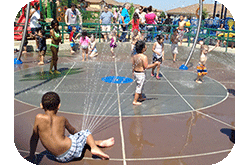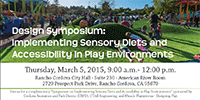|
|
The Role of Interoception in Play and Recreation
Author: Chad Kennedy, Landscape Architect, ASLA
 This year my kindergarten age son is learning about the five senses. His excitement for learning is nothing short of contagious as he analyzes daily interactions with the world based on which senses he is using. He correctly notices that an interaction with a tablet requires sight and touch and that his morning cereal feast results in taste and touch sensations. At times however, he is confused about which sensory system to attribute certain sensations. After an epic living room floor tickle battle he can correctly note that our laughter is attributed to the auditory sense but cannot quite describe the tickling sensation or his need for water. This may be attributed, in part, to a lack of recognition by society and elementary age educational programs that there are additional sensory systems beyond the typical five. Sensory systems which help us understand our bodies and the environment include the vestibular (balance & pressure), proprioceptive (spatial understanding) and interoceptive (internal organ) sensory systems. These systems are just as real and important as the traditional five, but receive much less attention. As past articles have focused on the vestibular and proprioceptive systems, this article will focus specifically on interoception and how it relates to play and recreational environments. This year my kindergarten age son is learning about the five senses. His excitement for learning is nothing short of contagious as he analyzes daily interactions with the world based on which senses he is using. He correctly notices that an interaction with a tablet requires sight and touch and that his morning cereal feast results in taste and touch sensations. At times however, he is confused about which sensory system to attribute certain sensations. After an epic living room floor tickle battle he can correctly note that our laughter is attributed to the auditory sense but cannot quite describe the tickling sensation or his need for water. This may be attributed, in part, to a lack of recognition by society and elementary age educational programs that there are additional sensory systems beyond the typical five. Sensory systems which help us understand our bodies and the environment include the vestibular (balance & pressure), proprioceptive (spatial understanding) and interoceptive (internal organ) sensory systems. These systems are just as real and important as the traditional five, but receive much less attention. As past articles have focused on the vestibular and proprioceptive systems, this article will focus specifically on interoception and how it relates to play and recreational environments.
Interoception
Interoception is primarily recognized by feelings or conditions that originate from the interoceptors inside the body. These feelings may include pain, temperature, stomach discomfort, itch, tickle, internal pressure, muscle sensations, hunger, thirst and air hunger.1,4 There are only a few distinguishable signals that are easily perceived (heartbeat and intestinal signals) while most other signals are relatively imperceptible.2 Interestingly, not everyone responds to, recognizes or "feels" internal stimuli in the same way. When a group of healthy people was surveyed as to if they could feel their heartbeat, only 65% could feel their own heartbeat. In addition, individuals with eating disorders don't feel the same pain associated with eating too much.9 Another example of differing internal signals is evident with those who experience headaches after skipping even one meal, where others can skip several meals in a row without experiencing severe stimuli. In reality, interoception is an individual awareness of internal stimuli.
Environment and Interoception
It is important to understand that our emotions and behaviors are directly tied to our state of comfort or "how we feel". Interaction between external environment stimuli and the internal body condition is directly related to behavior.2,6 Understanding of this interaction is the essence of interoception. When the basic needs of interoception are not met, the resulting discomfort can lead to negative behavior changes and less than enjoyable recreational experiences for all involved. Persons with disabilities are often impacted severely when internal signals change. Those with anxiety, panic disorders and post-traumatic stress disorder (PTSD), for instance are very aware of any minute changes to internal sensations, which often result in panic attacks. 9 Research also shows that the recognition of the heartbeat is associated with emotional state.7 Interoceptive needs transcend all ages, cultures, physical conditioning and any physiological or cognitive limitations.
As building codes typically do not directly address issues related to interoception, pro-active design is crucial to insuring that those recreating are provided for. The following are a few ways to satisfy interoceptive needs in outdoor environments.
Restrooms - Whenever possible provide restrooms. Restroom facilities should be adequate for the number of users, should meet all health and ADA codes and should always include infant changing stations. Every user has a different threshold related to how long they can wait before using the restroom and internal signals often don't allow much time before action must be taken. Thresholds may also be dependent on age, disability and health condition. For families that live in the vicinity of a recreational facility, a restroom is not very important, but for those who travel even short distances by car or foot, rushing to locate a restroom can be extremely frustrating. Understandably, budgets do not always allow for restrooms, but when at all possible, providing a restroom is crucial. Drinking Fountains / Bottle Fillers - There are very few reasons why a drinking fountain should be omitted from a recreational space. Thirst is universal and is easily satisfied. Water from a fountain can also be used to clean cuts and scrapes and to sooth hot skin. Shade - Though most people can self-regulate their body temperature by seeking out shade, many do not or cannot recognize internal stimuli to cool down. Providing ample shade in active recreation areas through the use of shade structures, shade sails, trees, arbors and other structures, people can recreate while in the shade without the need to seek it out. There are many in the population that have skin sensitivities as well that can only handle limited amounts of exposure.  Wet Play - In addition to shade, inclusion of water in or near recreational areas is an extremely effective method for cooling the body. The most common, though expensive methods are pools and splashpads, however, misters and small sprays are also available. These need to be carefully planned to meet health codes and should be installed with non-slip surfaces to avoid creating a hazard. Wet Play - In addition to shade, inclusion of water in or near recreational areas is an extremely effective method for cooling the body. The most common, though expensive methods are pools and splashpads, however, misters and small sprays are also available. These need to be carefully planned to meet health codes and should be installed with non-slip surfaces to avoid creating a hazard.
Picnic / Vending Facilities - As young children often have a limited threshold for hunger and thirst pains, young families in particular understand the need for a convenient location to hydrate, eat snacks, and prepare meals. Opportunities for vendors or machines where feasible are often great ways to provide for those who come un-prepared. Picnic areas should provide ample shade and be within a relatively close distance to parking and activities. Resting Nodes - In order to be fully aware of interocepetive signals, retreat into solitary environments, where other sensory systems are not taxed is sometimes required. For some this may be a bench to the side of a trail, to others, this may require a cozy hiding place just large enough for one individual. The key is to provide many varied opportunities in the environment for restful contemplation and attention to internal stimuli. Low Allergy Plants - Allergies and hayfever are an ongoing difficulty in our urban environments overplanted with many high pollen offending trees and shrubs. Exposure in the environment can cause itchy scratchy eyes and congested sinus cavities. If planners choose plant selections wisely, at least at a micro scale, users of a particular space will be less impacted by allergens in the air and hopefully will have a better experience. The OPALSTM Allergy Scale is a great resource for determining which plants will minimize the levels of pollen in the air. Non-Toxic / Non-Irritant Plants - Many common plants in the urban environment actually have properties that are non-conducive to recreational environments. Due to skin sensitivities and toxic properties if ingested, many plants should not be considered when selecting plants. These plants include those with major or minor toxic properties, plants containing oxalates, plants that cause dermatitis or those that are considered toxic to animals. The UC Davis Toxic Plant List is a great resource for determining toxicity levels of plants. Remove Hazards - One way of limiting pain associated with trips, scrapes and bruises is to minimize hazards in the environment. It sounds simple, but with proper planning unnoticed details can avoid unintentional hazards in the environment. The addition of a raised curb at the ends or sides of ramps can help avoid wheels drifting off edges, clear and proper paths of travel can limit the need to take short cuts across uneven terrain and sign posts and other structures can be located to avoid conflicts with users. Universal design guidelines are a good resource for avoiding many common hazards.
Though often neglected, interoceptive stability is of paramount importance for enjoyable experiences in outdoor environments. During your next outdoor adventure, take advantage of the opportunity to pay attention and learn from the internal messaging you may normally take for granted.
To learn more about landscape architecture related topics please visit our publications center.
1-Craig, Ad. Interoception: The Sense of the Physiological Condition of the Body. Current Opinion in Neurobiology. 13:500-505. 2005.
2-Ferri, Francesca. Martina Ardizzi, MArianna Ambrosecchia and Vittorio Gallese. Closing the Gap Between the Inside and the Outside: Interoception Sensitivity and Social Distances. PLOS One. 8:10:1-11. 2013
3-Mehling, Wolf E., Jennifer Daubenmier, Cynthia Price, Mike Acree, Elizabeth Bartmess and Anita Stewart. Self-reported Interoceptive Awareness in Primary Care Patients with Past or Current Low Back Pain. Journal of Pain Research. 6:403-418. 2013.
4-Paulus, MArtin P. and Murray B Stein. Interoception in Anxiety and Depression. Brain Structure Function. 214:451-463. 2010.
5-Star Center. What is SPD?. http://spdstar.org/what-is-spd/. Accessed Nov.2014. Updated 2014.
6-Wiebking, Christine. Moritz de Greck, Niall Duncan, Alexander HEinzel, Claus Tempelmann and Georg Northoff. Are Emotions Associated with Activity During Rest or Interoception? An Exploratory fMRI Study in Healthy Subjects. Neuroscience Letters. doi10.1016/j.neulet.2011.01.012. 2011
7-Wiens, Stefan. Interoception in Emotional Experience. Current Opinion in Neurology. 18:000-000. 2005
8-Zaki, Jamil. Joshua Davis and Kevin Ochsner. Overlapping Activity in Anterior Insula During Interoception and Emotional Experience. doi:10.1016/j.neuroimage.2012.05.012. 2012
9-Madhusoodana, Jyoti and Elana Ryznar. Science Notes 2014: Inner Selfie. University of California, Santa Cruz. 26 FEB. 2015. http://sciencenotes.ucsc.edu/2014/pages/selfie/selfie.html
|
|
|
|
 This year my kindergarten age son is learning about the five senses. His excitement for learning is nothing short of contagious as he analyzes daily interactions with the world based on which senses he is using. He correctly notices that an interaction with a tablet requires sight and touch and that his morning cereal feast results in taste and touch sensations. At times however, he is confused about which sensory system to attribute certain sensations. After an epic living room floor tickle battle he can correctly note that our laughter is attributed to the auditory sense but cannot quite describe the tickling sensation or his need for water. This may be attributed, in part, to a lack of recognition by society and elementary age educational programs that there are additional sensory systems beyond the typical five. Sensory systems which help us understand our bodies and the environment include the vestibular (balance & pressure), proprioceptive (spatial understanding) and interoceptive (internal organ) sensory systems. These systems are just as real and important as the traditional five, but receive much less attention. As past articles have focused on the
This year my kindergarten age son is learning about the five senses. His excitement for learning is nothing short of contagious as he analyzes daily interactions with the world based on which senses he is using. He correctly notices that an interaction with a tablet requires sight and touch and that his morning cereal feast results in taste and touch sensations. At times however, he is confused about which sensory system to attribute certain sensations. After an epic living room floor tickle battle he can correctly note that our laughter is attributed to the auditory sense but cannot quite describe the tickling sensation or his need for water. This may be attributed, in part, to a lack of recognition by society and elementary age educational programs that there are additional sensory systems beyond the typical five. Sensory systems which help us understand our bodies and the environment include the vestibular (balance & pressure), proprioceptive (spatial understanding) and interoceptive (internal organ) sensory systems. These systems are just as real and important as the traditional five, but receive much less attention. As past articles have focused on the  Wet Play - In addition to shade, inclusion of water in or near recreational areas is an extremely effective method for cooling the body. The most common, though expensive methods are pools and splashpads, however, misters and small sprays are also available. These need to be carefully planned to meet health codes and should be installed with non-slip surfaces to avoid creating a hazard.
Wet Play - In addition to shade, inclusion of water in or near recreational areas is an extremely effective method for cooling the body. The most common, though expensive methods are pools and splashpads, however, misters and small sprays are also available. These need to be carefully planned to meet health codes and should be installed with non-slip surfaces to avoid creating a hazard.
